Toilet Fill Valve Types, How they Work, Parts & the Best
It’s a harmonious mechanism whereby you flush the toilet and, when you come back, you simply flush it again and there’s always the same amount of water to do the job right. Inside the toilet tank is a system of interrelated parts including a toilet fill valve that specifically controls the amount of water that gets in after flushing.
The most common types of toilet fill valves include float cups, floatless, and the old-style piston and plastic/brass diaphragm ballcocks. While they perform the same function, keeping the tank filled always, they come in unique designs and working mechanisms.
Understanding how each type works is important in solving the issues that may arise when using the toilet. Following are details of the types including a review of the best fill valves.
What is a Toilet Fill Valve & How it Works
The toilet fill valve is a series of interconnected parts inside the toilet tank that’s responsible for controlling the water flow that refills the tank.
It doesn’t take part in the flushing of the toilet as this role is for the flush valve. However, the two are interrelated as flushing the toilet also activates the fill valve to allow water into the tank.
It’s made up of a mechanism to measure the level of water which in most cases, is a floater that moves up and down with the level of water. When the level drops below a certain maximum point, the fill valve lets in water until the maximum level is attained again.
Others use a pressure-sensing mechanism to detect when the water is present or absent from the toilet tank.
Toilet Fill Valve Types with Diagrams & Parts
Fill valves are named after the mechanisms they use to control the water level in the tank. Toilet fill valves can be broadly classified into modern fill valves including float cups and floatless and old-style floatball fill valves including the plunger/piston ballcock and Diaphragm ballcocks(Plastic and brass bodies)
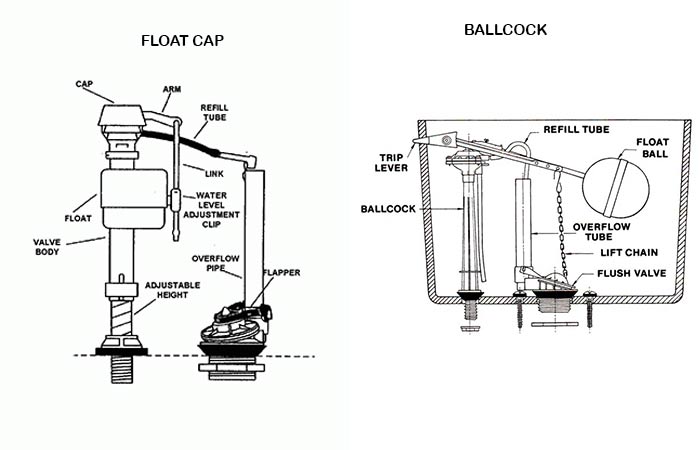
Float Cup Fill Valve
This type of fill valve lacks the traditional floating ball and instead has a circular cup made of plastic that moves up and down a shaft with the level of water in the toilet tank.
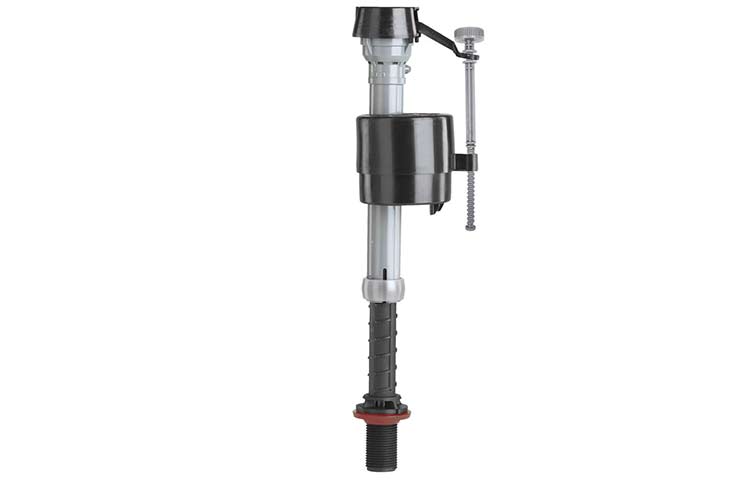
It’s one of the most reliable types of fill valves as it has fewer moving parts and is very easy to adjust.
When the toilet is flushed, the floating cup drops to the base of the shaft and opens the water inlet. As the water flows into the toilet tank, it raises the cup upwards until it reaches a point where the inlet is closed again.
On some float cup valves, there is a plastic screw mechanism you can turn to raise or lower the float
Most of the float cup valves come with a plastic screw mechanism that allows you to adjust the level of water in the tank. All you need is to turn it to raise or lower the float.
Internal Float Type Fill Valve
This is a newer variation of the float cup type with a concealed internal and smaller float lever inside the head of the valve. Compared to the external float cups, internal floats have a condensed design and have a precise shut-off.
Given that the water inlet is also inside the fill valve, it’s very quiet and some manufacturers have named this type of valve QuietFill.
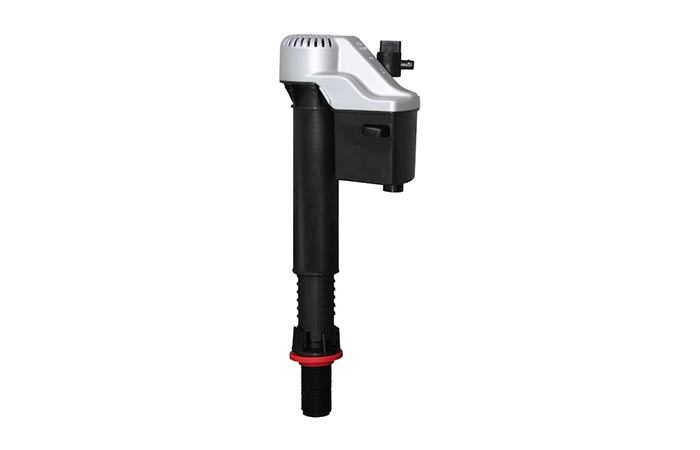
To adjust an internal float, twist the top head of the fill valve counterclockwise to unlock it. Y move in up or down as needed, then lock it with a clockwise turn.
Floatless Fill Valve(Pressure-assisted)
As their name suggests, this type of fill valve does not have a float cup or ball. Instead, they use a pressure-sensing diaphragm at the base of the tank. The valve operates underwater and shuts when the pressure is at its maximum.
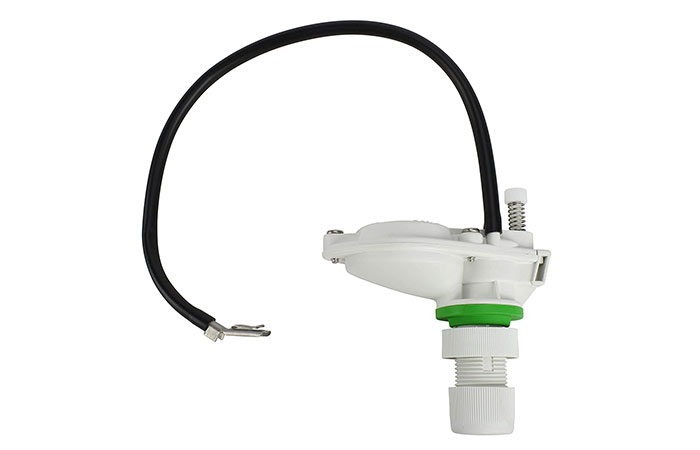
Floatless valves were created to serve low-flow toilets. They’re usually made of plastic, are cheap highly reliable.
To adjust a floatless valve, turn the adjustment screw on the top of the valve to raise or lower the water level.
Plunger/Piston Type Fill Valve(Old-style)
The plunger/piston fill valve uses a plunger or piston system to open and close the water inlet into the toilet tank. The inlet is the bottom-fill type which means that water is injected into the tank from below rather than from above.
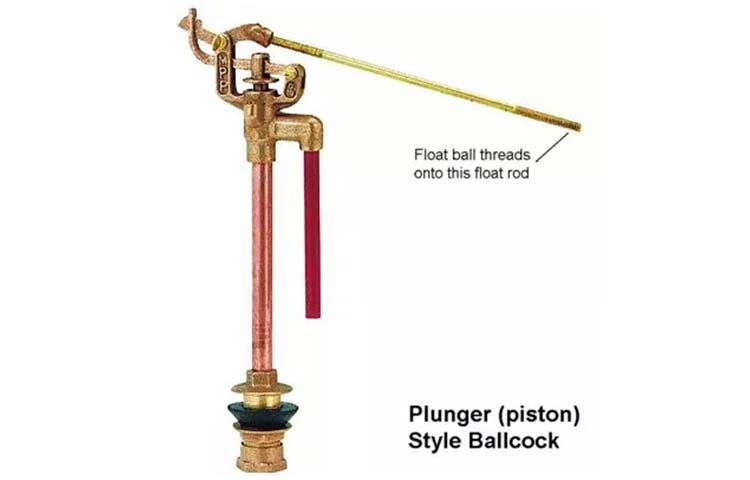
The piston or plunger is attached to a brass rod which is in turn attached to a floating ball at its end. The floating ball stays on top of the water surface at all times.
When the toilet is flushed, the ball drops to its lowest level. As it does so, it moves the brass rod with it. The brass rod moves the piston which opens the water inlet.
As the water flows into the toilet tank and its level raises up, the ball is raised as well as the rod it is attached to. The rode raises the piston and slowly closes it until it’s completely closed when the tank is full.
To change how much water flows into the toilet tank, you bend the brass rod either up to raise the water level, or downwards to lower the water level. Keep in mind that you should keep the water level within a given maximum level.
Diaphragm Type (Brass & Plastic)
Brass
The diaphragm type fill valves are almost similar to the piston type as they also feature a brass rod that has a float ball at its end. This also floats in sync with the water level.
However, instead of the brass rod changing the setup of a piston, it has a diaphragm seal inside a round valve body. The brass part refers to the material the diaphragm is made from as there’s a plastic version of it.
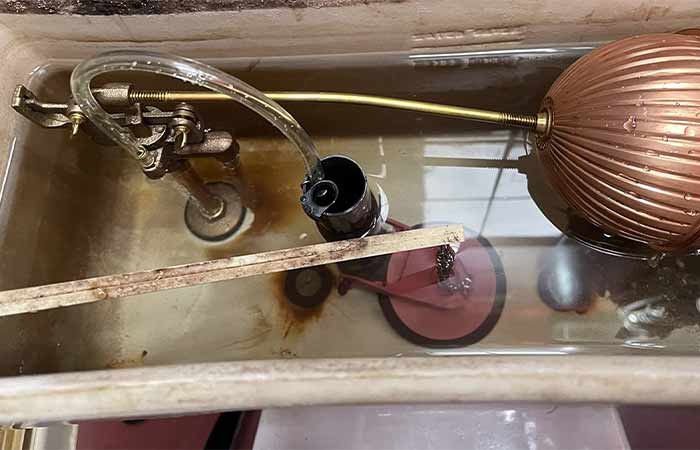
When the toilet is flushed, the floater moves downwards and moves the brass rod with it. This brass rod presses on top of the diaphragm which then opens the water inlet into the toilet tank.
As the water fills up, it moves the floating ball upwards with it. The ball moves the brass rod which releases the pressure on the diaphragm. In this way, the diaphragm slowly closes the water inlet until it’s closed.
To adjust the amount of water that goes into the toilet tank, you bend the brass rod connecting the floating ball to the diaphragm up for more water and down for less water.
Plastic
The setup for this type of fill valve is the same as that of the brass diaphragm fill valve.
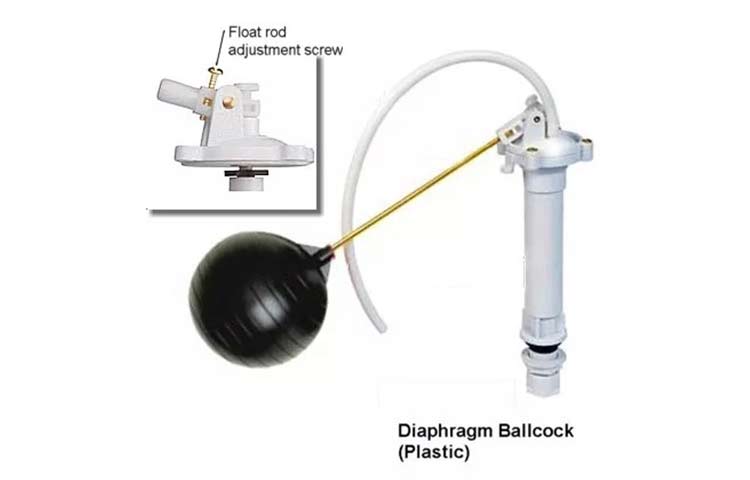
It even works in a similar manner with the downward movement of the ball opening the diaphragm and upward motions closing the diaphragm and water inlet.
The main difference is that the diaphragm is made of plastic material rather than brass.
Also, instead of bending the brass rod to adjust the water level in the tank, you turn the floating rod adjustment screw at the top of the diaphragm setup.
A clockwise turn lowers the water level while a counterclockwise turn increases the water level in the tank.
Best Toilet Fill Valves
Looking for a new fill valve to replace an old or damaged one? Below is a review of the best fill valves based on the types discussed above.
Fluidmaster 400AH PerforMAX
PerforMAX is a toilet fill valve built for performance. It eliminates noise while generating 2X greater refill rates than standard fill valve designs.
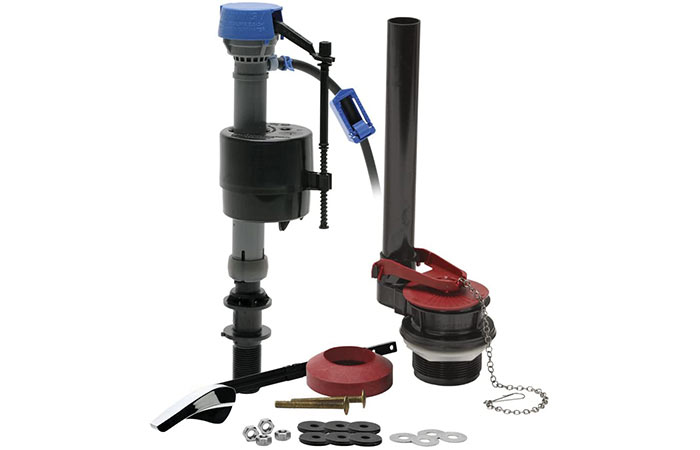
It comes with a universal design that adjusts easily from 10 – 15 inches and is ideal for use in high efficiency 1.28 to 1.6 gallons per flush toilets.
You can easily install it in less than 10 minutes.
A water-saving roller clamp lets you regulate the fill level in the bowl to help save water and money.
Another top and highly rated product from Fluidmaster that is not built for performance is the 400CRP14 universal fill valve.
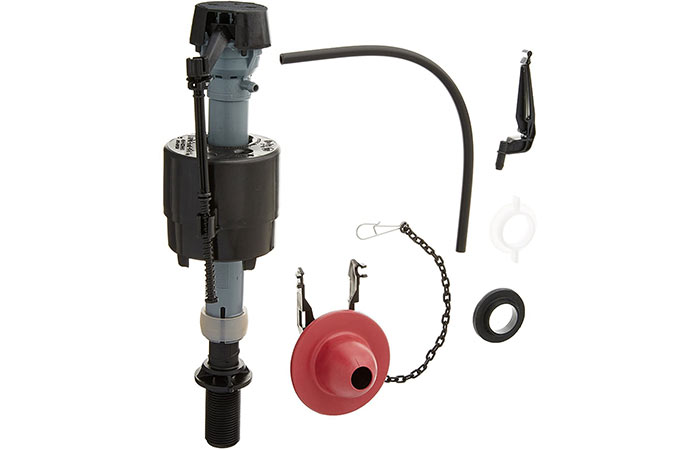
It is an easy-to-install toilet fill valve that adjusts from 9 – 14 inches, fits most 2-inch flush valve toilets, and is ideal for use in 1.6 to 3.5 gallons per flush toilets or larger.
Korky 528 Universal Fill Valve
This is one of the most reviewed fill valves on the internet. With an easy-to-install and universal design, Korky QuietFill is one of the perfect replacements for noisy, old, and damaged ballcocks in your 2-piece and 1-piece toilets.
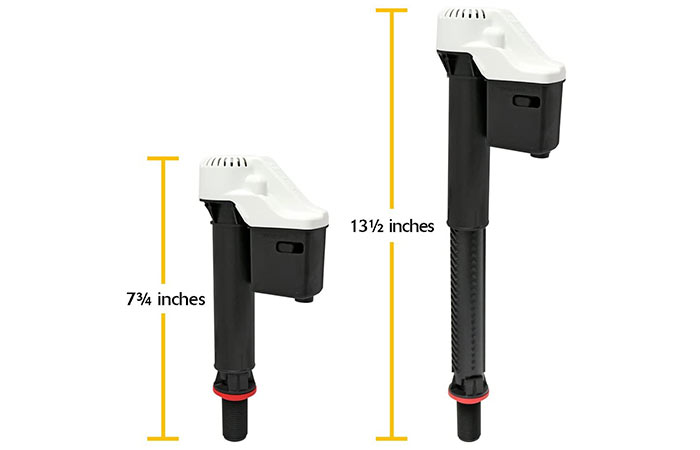
It is adjustable from 7.75” to 13.5.” and has a twist-lock adjustment that makes installation the easiest when you’re doing toilet repairs.
Comes with durable chlorazone red rubber that resists chlorine, bacteria, city water treatment, hard & well water.
Toto TSU99A.X Universal Fill Valve
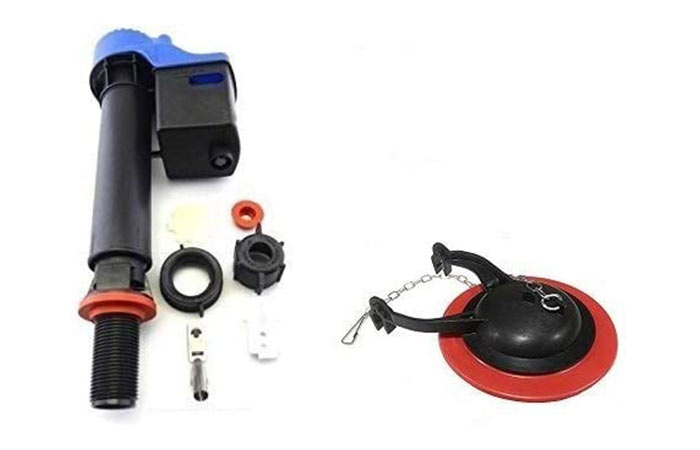
If you have a Toto toilet, this universal fill valve and flapper kit is the perfect solution. Comes with an adjustable height and flow rate.
Kohler Genuine Peart Gp1083167
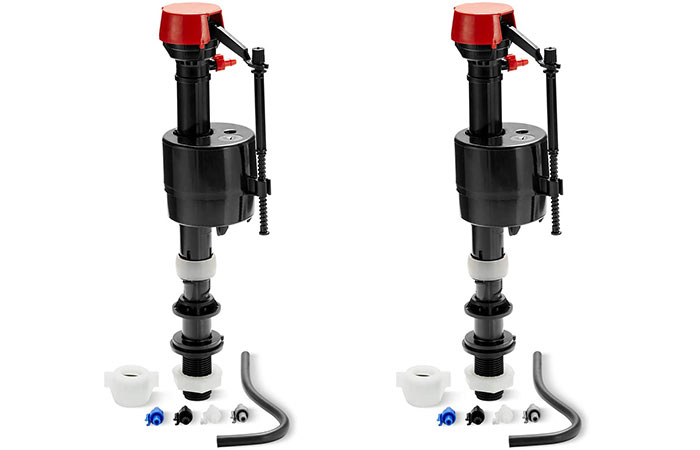
This fill valve kit is designed for all Kohler Class Five Toilets,12.5″ x 3.5″ x 3″. The silent fill provides a gracious experience by filling the tank quietly.
Multiple fill rate inserts are provided to optimize performance and conserve water. It is also adjustable to accommodate any height.
Plumb Pak PP830-12 Ballcock
If you still have the old-fashioned all-brass fill valve, this option is for you. It is designed for 8-1/2 in or higher Mansfield and other toilet tanks.
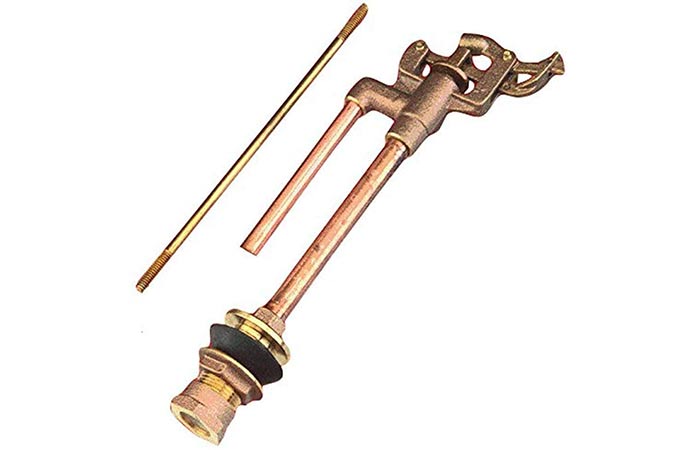
Plumb Pak K830-14
The K830-14 is a replacement for a damaged floatless fill valve. It is a non-anti-siphon fill valve ideal for Standard 2-piece toilets.
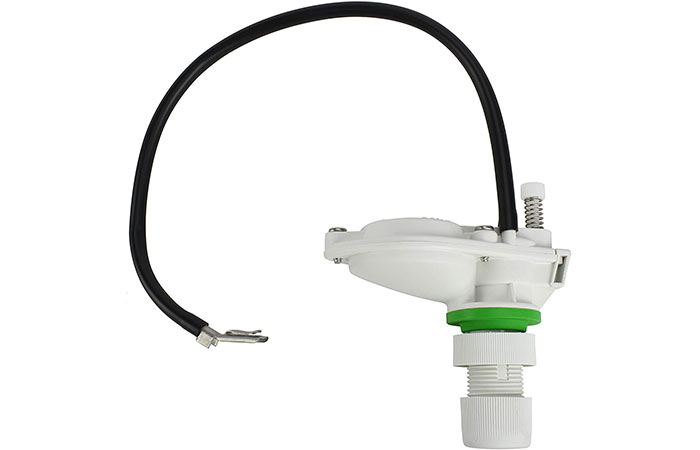
Danco Complete Toilet Repair Kit Fill Valve.
If you are looking for a plastic diaphragm type of fill valve, the Danco kit is one of the best choices. The durable plastic and rubber constructions provide strength and durability, which allows for optimal performance for standard single-flush applications.
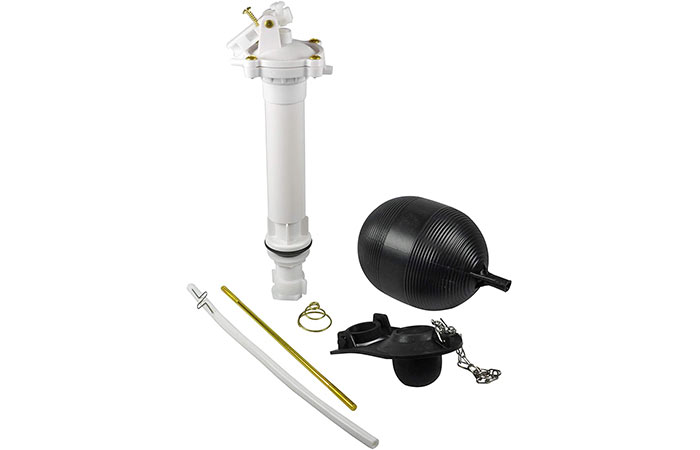
Tips to Choose the Correct Fill Valve Type.
The following are some ideas to consider when you are buying a replacement fill valve kit.
Compatibility
While most modern fill valves are universal, not all will fit into your toilet model, type or design. For instance, some universal fill valves won’t work well with dual flush toilets.
At the same time, newer designs are mostly incompatible with old ballcock designs. Be sure to check the exact type/model of toilet you have before buying a replacement kit.
Durability
Fill valves made of quality plastic and rubber parts tend to last longer compared to ones made of metals that easily rust.
Ease of installation
Most of these replacements should be DIY projects. You do not need to hire a pro plumber. Choose kits that take not a lot of time to install and with quick installation guides.
Performance
This is an important factor, especially for households or places with many people.
Pressure (Low/High)
Some fill valves such as the floatless work well with low-pressure toilets
Adjustability
Adjusting the height and float mechanism should be easy and quick.
Other factors include
- Water-saving
- Less noisy